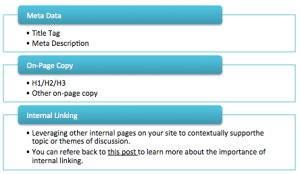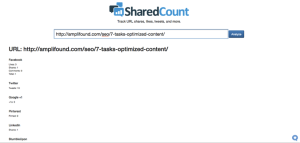Whether you’re a seasoned blogger with a large archive, or just starting out, conducting a content audit on existing pages or new pages can help refine and target your content for more search visibility.
So what is a content audit? A content audit is a process for creating an inventory of pages on your site and evaluating the content on them to determine if editing, revision, or additional copywriting is needed. It’s also helpful with prioritizing pages that can be optimized with keywords, meta data and internal linking in order to help increase traffic to the page, conversions and search engine visibility.
When we talk about optimizing a page, a content audit can be completed to optimize the following entities for specific blog posts or pages on your site to help improve search performance of these pages for targeted keywords.
I find one of the easiest ways to get started on a content audit is to start with an Excel template that will showcase the various posts or pages that you will be revamping. Using Excel makes it easier to uniformly update the content yourself or for sending over to your site developers for easy instruction and execution. So, start by opening up Excel and adding the following columns:
Now that you’ve created your excel document, we will go over a few free, easy to use tools that will help you organize where to begin with improving the content on your site or looking at specific blog post that you can further enrich with targeted keywords to help get them ranking. If you’re looking to perform a full content audit on all of your site’s pages (as long as it’s not an overwhelming amount of them), the best way to get started is to simply pull your sitemap and place all pages listed in it, into the Excel document for you to get started with revamping content.
First, you’re going to want to spend some time determining which keywords your site is ranking for already and which pages are ranking for which keywords.
Keywords
Again, whether your blog has been around for a long time or you’re just starting out, focusing on researching keywords and trending terms is incredibly helpful. Not only can narrowing your focus help you to create content that people want, but it also ensures that your content is optimized to show up in Google searches when your audience searches for specific topics. To see what keywords your site is ranking for or to determine opportunities for new keywords you may want to rank for, you can use SEMrush, a tool that can give you a number of keyword insights. .
- With a free SEMrush account, you’re limited to the amount of data you can see, but if you have enough content on your site, you can gather great insights into the type of keywords you’re ranking for.
- If your site is newer, SEMrush might not have much available data for you, take a look at other blogs that fall in the realm of the same type of content you want to write about and see what terms they are ranking for. From there you can determine the best keywords to help you fully optimize underperforming posts.
- If you’re looking at revamping certain sections of your blog or specific content topics, you can use this easy tool to search for keywords related to the section and determine if any pages of yours are ranking for terms. If they aren’t, then you should definitely include them in your content audit.
After seeing which keywords your site is already ranking for, you’re going to want to take a look at which blog post or pages are performing best with reader engagement. Which posts seem to be gathering the most social shares, links, or mentions from other bloggers or the most page sessions? Which posts don’t seem to be doing anything, or aren’t fully optimized for the topic of discussion? Here are a few different tools you can check out to start pinning down which posts are underperforming and leave room for improvement.
Backlinks
Determine which posts on your site are being shared by other bloggers or other sites linking to your post from their site. Some free tools you can use are:
- Opensiteexplorer.com – Either put in the URL of your site (Example: www.amplifound.com) or the URL of a specific landing page (Example: http://amplifound.com/seo/links-matter-seo/)
Social Shares
To pull social shares across all the different social channels you can use tools like:
- Sharedcount.com – simply input the URL of the post you are analyzing to pull up if you have any shares. This tool will look at shares across Facebook, Twitter, Pinterest, Google +1, Linkedin and Stumbleupon.
- Sharetally.co is another suggested tool that dives into even more social channels and shows you the various ways people are engaging with your content.
Visits to Site or Certain Pages
If you have Google Analytics set up for your blog, you’ll be able to find out how many visits each of your posts are getting based on organic searches or searches based on what your audience is searching for by using specific keywords. This will help give you good insight as to which pages are naturally gaining traffic (if you aren’t running any campaigns or doing linkbuilding techniques) and which pages are slacking on visits and views from your audience. You can learn more about how to use Google Analytics for measuring the engagement of your content in this post.
The Audit
Keywords:
Once you’ve pinpointed which pages on your site are underperforming, make sure you save the URL of that page in your Excel document. Try to take a high level approach by looking at overall sessions to the page, social shares, as well as keywords the pages might not be ranking for, but could be.
From here, begin filling in your content audit Excel sheet, starting with the keywords you’re targeting for that specific page or any keywords that relate to the topic at hand. Add your top keywords you want to target into the column next to the URL, this could be anywhere from 1 keyword to 10. Stick with focusing on keywords that might have lower search volume as this means they are less competitive to rank for, or any “long tail keywords.” Long tail keywords tend to be longer phrases people use to search with in Google. You can get examples of popular long term keywords by playing around with Google Suggest and other free keyword tools.
Once you’ve determined the keywords you want to target to that specific page, you can use Google’s keyword planner to get search volume, or Google’s data set for the average number of times a keyword is search for.
Content and Meta Data Optimization
Next, take a look at any current title tags, meta descriptions.
If pages are missing these entities, that’s a sign that those pages could definitely use a revamp and thorough examination of keywords for optimization. If each of your pages already have unique title tags and meta data, make sure that they include one of the main keywords you are targeting for that page.
After you’ve gone through and made sure all meta data includes proper keywords, it’s time to take a look at on-page content. This can be any of the header elements, like H1’s or H2’s and so on, as well as the specific content for that blog post.
Start pinpointing certain sentences within paragraphs where you can adjust words to incorporate your keyword or incorporate long tail phrases that still target the keyword you’re after. Don’t get too carried away and resort to keyword stuffing however. Just include keywords where they logically fit and flow with your content, making it an enjoyable reading experience that just “happens” to be crawled by search engines for your keywords. As a best practice, try to inject the content with variations of your keywords more than once within the content. If you’re trying to rank for “best chocolate cake recipe” and every paragraph starts with “the best chocolate cake recipe”… you’re doing it wrong. Adding too many of one type of keyword could actually do more to harm your blog than help it.
Auditing for low content
This brings us to another problem your content audit can address: having too little content on your blog. As you may know, or may have heard, Google runs on algorithms that work to ensure that content and websites are being created with their audiences in mind. Google hates sites that strictly create content just to kiss their butt in hopes of ranking higher within the SERPs, but they also despise sites that have no useful content whatsoever. You can read more about Google’s algorithm’s history over on Moz.
So, if you’re going to start a blog, and it’s about all the best chocolate cake recipes you’ve made, make sure to provide interesting, unique, fun and engaging content that will get readers to interact, rather than just posting the five ingredients needed for every single type of chocolate cake you’ve made. Tell a story about why you chose the recipe, how you made it your own, what it was like to bake the cake, and most importantly, get descriptive with how delicious it tasted!
While going through this portion of the content audit, include each paragraph or sentence you are editing or optimizing in your Excel document, so that you can keep a full inventory of all the changes. Be sure to highlight any of the changes you’re making by listing the location of the sentence or paragraph, as well as using a different font color to highlight the newly added content or keywords within the text.
Keep in mind the following when editing your pages for low content or optimizing to target keywords:
- Revamp pages that have low content
- Revamp older post that may be short
- Search in Google for any content of yours that may be duplicated on other sites.
- You can do this by copying the text and placing it into Google search box, this will check if any other sites might be stealing your text without your permission.
Pulling Inspiration from your Content Audit
Now that you’ve inventoried keywords your pages rank for and those that you want to target for specific pages, you can take a step back and check to see if there were any keywords you pulled that were left out. (Don’t forget to make sure you’re including these keywords in your title tags, meta descriptions, H1’s and on page content, too!)
With these additional keywords or long tail phrases, that may have not had a place in current content on your site, you can start to gather inspiration for new content for your blog. You can also see if currently ranking keywords need their own new landing page that will provide more useful information as opposed to the page they might be already ranking for.
Determine if these pages can be targeted in a more descriptive and user friendly landing page or if they can help you uncover more topics of interest that your audience wants to read about.
For more ideas on content inspiration related to keywords, check out our post on “3 Tactics to Uncover What Your Readers Really Want.”












